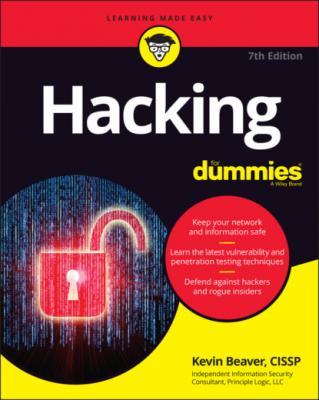Hacking For Dummies. Kevin Beaver
Читать онлайн.| Название | Hacking For Dummies |
|---|---|
| Автор произведения | Kevin Beaver |
| Жанр | Зарубежная компьютерная литература |
| Серия | |
| Издательство | Зарубежная компьютерная литература |
| Год выпуска | 0 |
| isbn | 9781119872214 |
Consider formal classroom training from the security-tool vendor or another third-party training provider, if available.
Look for these characteristics in tools for security testing:
Adequate documentation
Detailed reports on discovered vulnerabilities, including how they might be exploited and fixed
General industry acceptance
Availability of updates and responsiveness of technical support.
High-level reports that can be presented to managers or nontechnical types (especially important in today’s audit- and compliance-driven world)
These features can save you a ton of time and effort when you’re performing your tests and writing your final reports.
Executing the plan
Good security testing takes persistence. Time and patience are important. Also, be careful when you’re performing your tests. A criminal on your network or a seemingly benign employee looking over your shoulder may watch what’s going on and use this information against you or your business.
Making sure that no hackers are on your systems before you start isn’t practical. Just be sure to keep everything as quiet and private as possible, especially when you’re transmitting and storing test results. If possible, encrypt any emails and files that contain sensitive test information or share them via a cloud-based file sharing service.
You’re on a reconnaissance mission. Harness as much information as possible about your organization and systems — much as malicious hackers do. Start with a broad view and narrow your focus. Follow these steps:
1 Search the Internet for your organization’s name, its computer and network system names, and its IP addresses.Google is a great place to start.SAMPLE SECURITY TESTING TOOLSWhen selecting the right security tool for the task, ask around. Get advice from your colleagues and from other people via Google, LinkedIn, and YouTube. Hundreds, if not thousands, of tools are available for security tests. Following are some of my favorite commercial, freeware, and open-source security tools:Acunetix Web Vulnerability ScannerCain & AbelBurp SuiteCommView for WiFiElcomsoft System RecoveryLUCYManageEngine Firewall AnalyzerMetasploitNessusNetScanTools ProNetsparkerOmniPeekProactive Password AuditorProbelyQualysSoftPerfect Network ScannerI discuss these tools and many others in Parts 2 through 5 in connection with specific tests. The appendix contains a more comprehensive list of these tools for your reference.
2 Narrow your scope, targeting the specific systems you’re testing.Whether you’re assessing physical security structures or web applications, a casual assessment can turn up a lot of information about your systems.
3 Further narrow your focus by performing scans and other detailed tests to uncover vulnerabilities on your systems.
4 Perform the attacks and exploit any vulnerabilities you find (if that’s what you choose to do).
Check out Chapters 4 and 5 for information and tips on this process.
Evaluating results
Assess your results to see what you’ve uncovered, assuming that the vulnerabilities haven’t been made obvious before now. Knowledge counts. Your skill in evaluating the results and correlating the specific vulnerabilities discovered will get better with practice. You’ll end up knowing your systems much better than anyone else does, which will make the evaluation process much simpler moving forward.
Moving on
When you finish your security tests, you (or your client) will still need to implement your recommendations to make sure that the systems are secure. Otherwise, all the time, money, and effort spent on testing goes to waste. Sadly, I see this very scenario fairly often.
Chapter 2
Cracking the Hacker Mindset
IN THIS CHAPTER
Before you start assessing the security of your systems, it’s good to know a few things about the people you’re up against. Many security product vendors and security professionals claim that you should protect all of your systems from the bad guys — both internal and external. But what does this mean? How do you know how these people think and execute their attacks?
Knowing what hackers and malicious users want helps you understand how they work. Understanding how they work helps you look at your information systems in a whole new way. In this chapter, I describe the challenges that you face from the people who actually do the misdeeds, as well as their motivations and methods. This understanding better prepares you for your security tests.
What You’re Up Against
Thanks to sensationalism in the media, public perception of hacker has transformed from a harmless tinkerer to a malicious criminal. Nevertheless, hackers often state that the public misunderstands them, which is mostly true. It’s easy to prejudge — or misjudge — what you don’t understand. Unfortunately, many hacker stereotypes are based on misunderstanding rather than fact, and that misunderstanding fuels a continued debate.
Hackers can be classified by both their abilities and their underlying motivations. Some are skilled, and their motivations are benign; they’re merely seeking more knowledge. Still, other hackers may have malicious intent and seek some form of personal, political, or economic gain. Unfortunately, the negative aspects of hacking usually overshadow the positive aspects and promote the negative stereotypes.
Historically, hackers hacked
